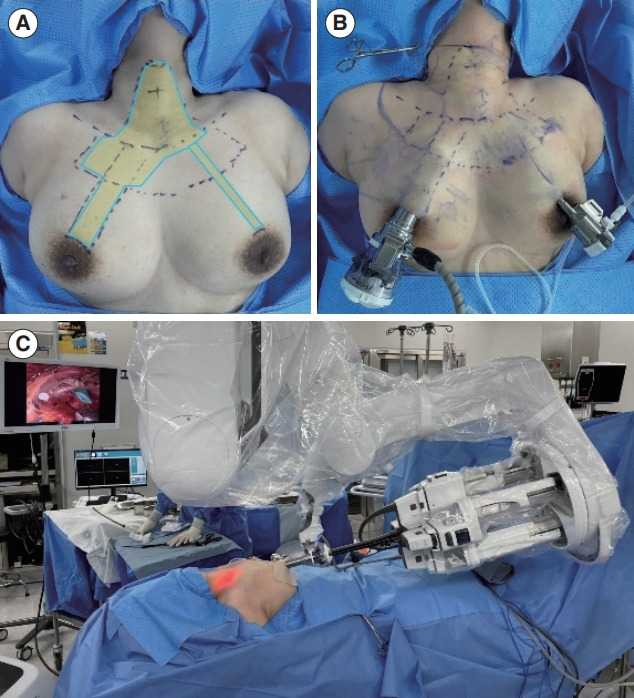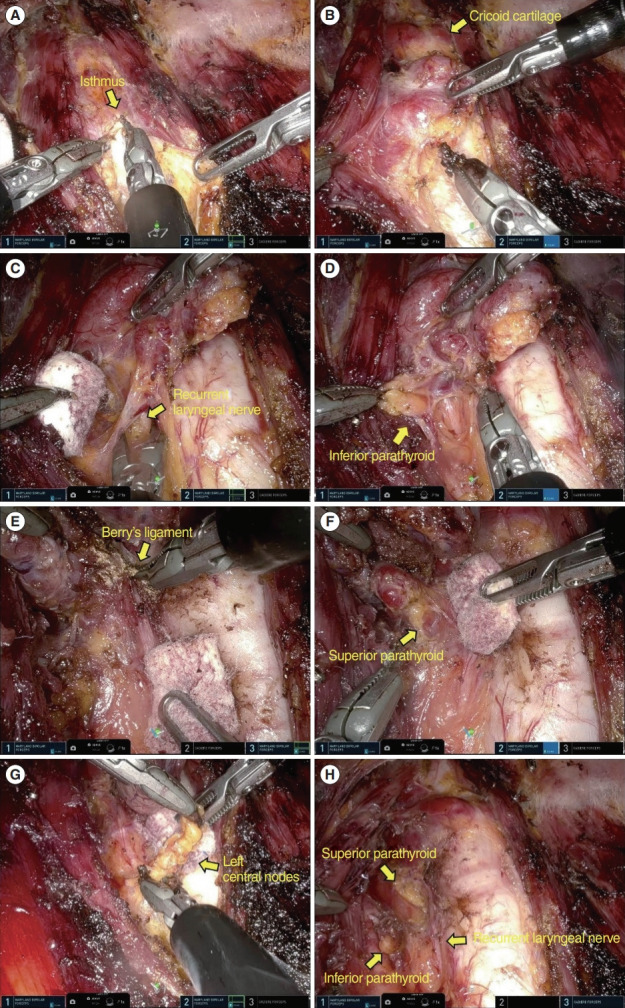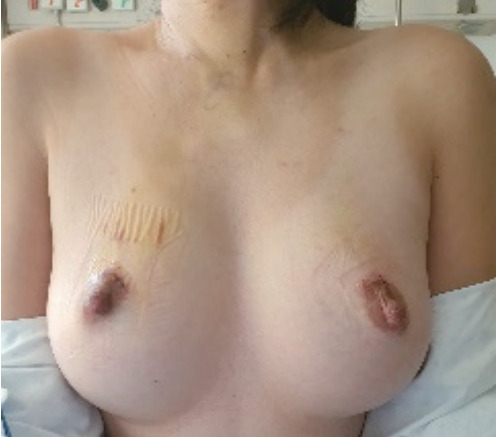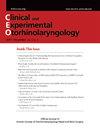单孔机器人乳晕入路甲状腺切除术的首次经验。
IF 3.4
3区 医学
Q1 OTORHINOLARYNGOLOGY
引用次数: 0
摘要
目的:许多微创甲状腺切除术技术已经开发出来,并在世界各地的医院中得到积极应用。在本文中,我们描述了最近开发的一种采用达芬奇SP的微创甲状腺切除术技术,并介绍了单孔机器人乳晕甲状腺切除术(SPRA)的初步临床结果。方法:在右侧乳晕处做一个3cm的半圆形切口,在左侧乳晕处做一个8mm的小切口。利用水解剖和先进的双极装置,创建了一个皮下皮瓣,从乳晕延伸到甲状腺软骨。然后通过右乳晕切口插入达芬奇SP。在2022年12月至2023年3月期间,进行了21次SPRA程序。随后审查了患者的医疗记录和手术录像。结果:行肺叶切除术17例,胸骨切除术2例,甲状腺全切除术2例。平均皮瓣时间14.9±4.2分钟,控制时间62.4±17.1分钟。肿瘤平均大小为0.89±0.65 cm,淋巴结清扫数为3.94±3.98个(范围0 ~ 12)。没有观察到声带麻痹或甲状旁腺功能减退的情况。结论:我们在世界范围内首次成功研制并实施了新型SPRA。不像其他机器人手术。方法:SPRA创伤小,无明显疤痕。这项技术采用了一个复杂的单端口机器人装置。然而,为了评估这种方法的有效性,我们需要在不久的将来分析更多的案例并进行比较研究。本文章由计算机程序翻译,如有差异,请以英文原文为准。



First Experience of Single-Port Robotic Areolar Approach Thyroidectomy.
Objectives Numerous minimally invasive thyroidectomy techniques have been developed and are actively utilized in hospitals around the globe. Herein, we describe a recently developed minimally invasive thyroidectomy technique that employs the da Vinci SP, and we present the preliminary clinical outcomes of single-port robotic areolar thyroidectomy (SPRA). Methods A 3-cm semi-circular incision on the right areola and a small 8-mm incision on the left areola were created. Using hydro-dissection and an advanced bipolar device, a subcutaneous skin flap was created, extending from the areola to the thyroid cartilage. The da Vinci SP was then inserted through the incision in the right areola. Between December 2022 and March 2023, 21 SPRA procedures were conducted. Patients’ medical records and surgical videos were subsequently reviewed. Results Lobectomy was performed in 17 patients, isthmectomy in 2 patients, and total thyroidectomy in 2 patients. The mean flap time was 14.9±4.2 minutes and the console time was 62.4±17.1 minutes. The mean tumor size was 0.89± 0.65 cm and the number of retrieved lymph nodes was 3.94±3.98 (range, 0–12). There were no observed instances of vocal cord palsy or hypoparathyroidism. Conclusion We successfully developed and performed the novel SPRA for the first time worldwide. Unlike other robotic surgery methods, SPRA is less invasive and leaves no visible scars. This technique employs a sophisticated single-port robotic device. However, to assess the efficacy of this method, we need to analyze more cases and conduct comparative studies in the near future.
求助全文
通过发布文献求助,成功后即可免费获取论文全文。
去求助
来源期刊
CiteScore
4.90
自引率
6.70%
发文量
49
审稿时长
6-12 weeks
期刊介绍:
Clinical and Experimental Otorhinolaryngology (Clin Exp Otorhinolaryngol, CEO) is an international peer-reviewed journal on recent developments in diagnosis and treatment of otorhinolaryngology-head and neck surgery and dedicated to the advancement of patient care in ear, nose, throat, head, and neck disorders. This journal publishes original articles relating to both clinical and basic researches, reviews, and clinical trials, encompassing the whole topics of otorhinolaryngology-head and neck surgery.
CEO was first issued in 2008 and this journal is published in English four times (the last day of February, May, August, and November) per year by the Korean Society of Otorhinolaryngology-Head and Neck Surgery. The Journal aims at publishing evidence-based, scientifically written articles from different disciplines of otorhinolaryngology field.
The readership contains clinical/basic research into current practice in otorhinolaryngology, audiology, speech pathology, head and neck oncology, plastic and reconstructive surgery. The readers are otolaryngologists, head and neck surgeons and oncologists, audiologists, and speech pathologists.

 求助内容:
求助内容: 应助结果提醒方式:
应助结果提醒方式:


